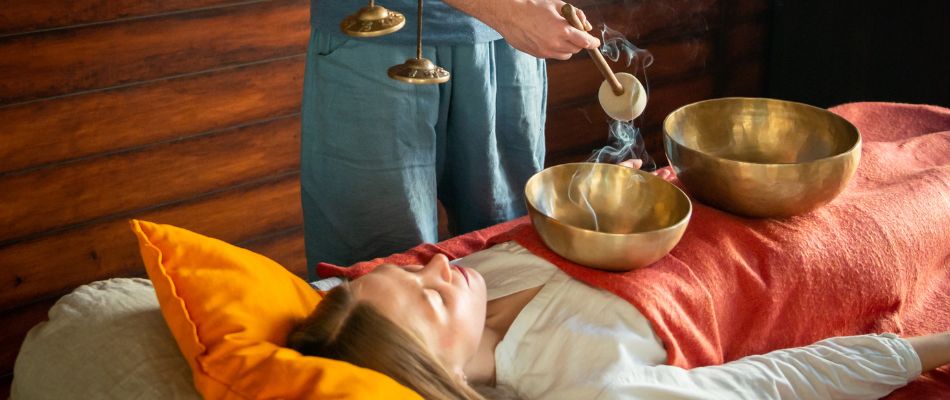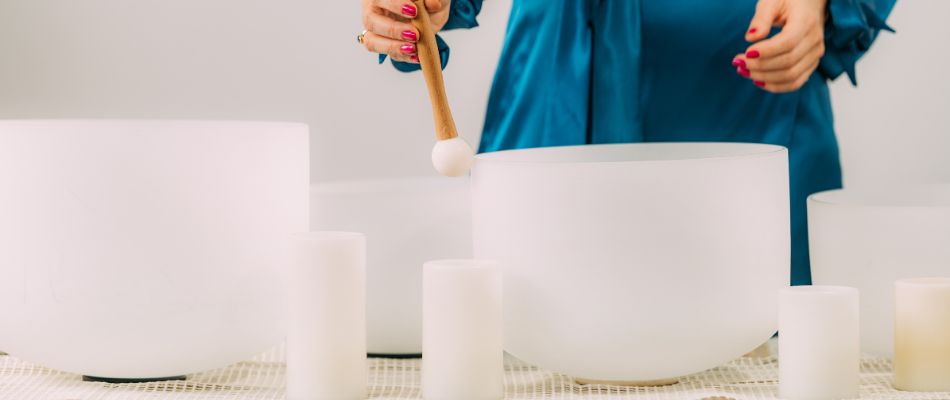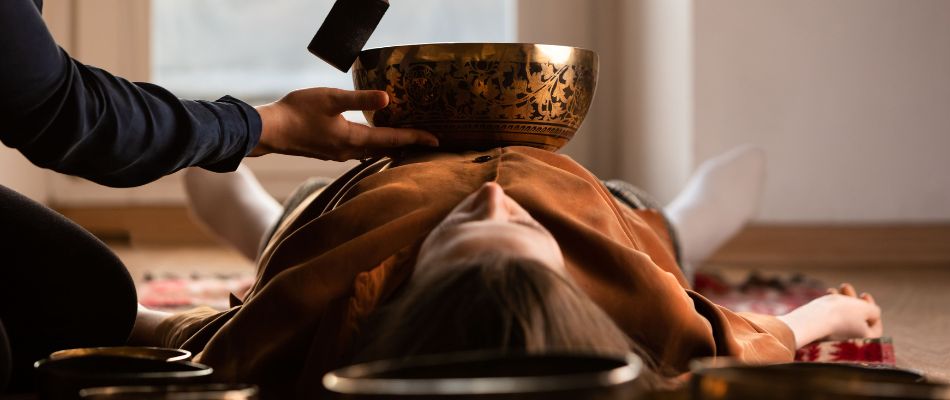Our local yoga and meditation center had an open week where community members could take any of the many classes they offer. I have experimented with many styles of meditation over the years but sound bath meditation was one that escaped me. I began researching the primary styles of meditation several years ago both out of curiosity and because students in our class often asked about the different types of meditation they should do. This creates an ethical dilemma when students have medical issues because they may have heard that a type of meditation helps with their condition and they are asking me to validate it. So I dug into the research on sound bath meditation and off I went in search of a class.
In a sound bath meditation, attendees lie comfortably on the mats as instructors use Tibetan metal bowls, crystal bowls, and gongs to create a resonating frequency that causes deep relaxation. Typically, sound bath meditations are 60 minutes and are conducted in groups.
My experience was shockingly enjoyable and what I learned has great promise for people needing relaxation and improvements in sleep. However, there are certain benefits attributed to sound bath meditation that haven’t really been proven in research to date. Here’s what I want you to know: If you have a sound bath meditation center near you, sound baths are worth the experience. And, no matter what you are feeling, a sound bath will probably make you feel better. Third, the communities that the schools create are full of the kindest, most fun people. The word “cure” should not in good conscious be used at all though.

Sound Baths are a Gateway to Relaxation and Deeper Meditation
Sound bath meditation is a unique and immersive relaxation technique that combines meditation with the soothing sounds of various instruments, such as singing bowls, gongs, chimes, and other percussion instruments. It offers a deeply calming and rejuvenating experience for both the mind and body.
I have to admit that before I went to the sound bath session I was expecting it to be a little far out there or even a bit kooky. Yes, you are laying on the floor with strangers while gongs and bowls are being clanged around you. Hard not to seem kooky. But it was a really nice experience, with really great people, and not so strange after all. It was also extremely unique.
When have you ever gotten together with a group of strangers with the sole purpose being to relax for a solid 60 minutes?
What to Expect From a Meditation and Sound Bath Experience
When you attend a sound bath meditation class, here’s what you can typically expect to experience:
Comfortable Setting: The class is usually held in a serene and comfortable environment, often in a quiet room with soft lighting and comfortable seating arrangements, like mats or cushions.
Guided Relaxation: The session may start with a brief introduction and some gentle guidance on relaxation and breathing techniques. This helps participants settle into a state of calm and receptivity.
Sound Instruments: The heart of a sound bath is the array of instruments used by the facilitator or practitioner. These instruments are specifically chosen for their ability to produce harmonious and resonant sounds that can help induce a state of deep relaxation. Common instruments include Tibetan singing bowls, crystal bowls, chimes, gongs, and drums.
Sound Journey: During the session, the facilitator or practitioner will play these instruments in a carefully orchestrated manner. The sounds created are designed to wash over you, like waves, enveloping you in a symphony of soothing vibrations. The vibrations are not just heard but felt as well, as they gently reverberate through your body.
Meditative State: As the sound bath progresses, participants are encouraged to let go of their thoughts and focus on the sounds. The goal is to enter a meditative state where you become more in tune with your breath, sensations, and the present moment.
Physical and Mental Relaxation: Many people report a deep sense of relaxation and stress relief during a sound bath. The vibrations and sounds can help release physical tension, calm the mind, and reduce anxiety. It can be a profoundly peaceful and restorative experience.
Personal Experience: Everyone’s experience with sound bath meditation is unique. Some may have visualizations or insights, while others may simply enjoy a sense of tranquility and a break from daily stressors. There are no right or wrong experiences.
For me, this is kind of hard to explain. I came out of the session feeling very giddy and wanting to joke around a lot. It’s like I had let myself get too serious worrying about things or just thinking too much at work. I wasn’t relaxed in the sense that I wanted to go to sleep but kind of felt like you do three days into vacation when you set down your regular life and still have a while before you head back home.
Closing and Sharing: After the sound bath, there’s often a gentle transition back to the present moment. Participants may be invited to share their experiences or thoughts, though this is usually optional. The session typically ends with a few moments of quiet reflection and gratitude.
Overall, the sound bath class has been one of the most enjoyable, inexpensive, easy, fun, unpretentious, things that I have done in a really long while. Something I experienced that flies completely under the radar is how great the people are. People going to a class like this just want to feel good and relax. It was so nice to spend 60 minutes with nice people, hearing no complaints, phone calls, worries, and no expectations that you would make small talk. Just lay there. I guess that is why I like the beach so much.

Investigating the Benefits of Sound Bath Meditation
Having had such a great experience with the sound bath class I was immediately intrigued by what could possible be going on in my body and the physical and mental health benefits of sound baths. What I found was good, but sound bath meditation is probably on of the least researched forms of meditation. There are some findings though and more research is becoming available as studies in other languages are being translated and compiled. Here are the two main take-aways I want you to get from this section:
Some people just want to experience relaxation and feel better without following instructions, the need to learn something, talk it out, or undertake an intellectual battle. Most forms of meditation have some sort of learning curve or take time to get benefits. Not sound bath meditation. You walk in, lay down, feel good. End of story.
Journal of Sleep Research
Sound bath causes extremely deep relaxation. Deep relaxation is associated with reductions in anxiety and a cortical response that promotes healing. Sound baths improve deep sleep. Deep sleep is also associated with healing, heart health, and blood sugar maintenance. So at the very least, sound bath meditation indirectly promotes health.
What Happens in the Brain During a Sound Bath?
The best way to understand the benefits of sound bath meditation is to take a look at what is going on in the brain during a class. Several intriguing mental processes occur which contribute to the overall experience of relaxation and altered consciousness. While research in this specific area is ongoing, neuroscientific studies and anecdotal evidence provide insights into what happens in the brain during a sound bath:
Auditory Processing: When you listen to the sounds produced by instruments like singing bowls, gongs, or chimes, your auditory cortex becomes highly active. This part of the brain processes and interprets the incoming auditory information, allowing you to perceive the unique tones and vibrations created during the sound bath.
Shift in Brainwaves: Sound baths often induce a shift in brainwave patterns. The brain operates at different frequencies depending on our mental states. During meditation and relaxation, people tend to shift from the beta state (associated with active thinking) to the alpha or theta states, which are characterized by increased relaxation and creativity. Sound vibrations may help facilitate this shift, promoting a deeper meditative state.
Sensory Integration: The brain integrates sensory input from multiple sources, including auditory, tactile, and proprioceptive (sensations of body position and movement) information. The vibrations and sounds generated during a sound bath engage various sensory pathways, contributing to a sense of full-body relaxation and grounding. The other meditation that focuses so strongly on sensory integration is walking meditation. It’s interesting to think that you can accomplish the same thing laying down.
Reduction in Stress Response: The soothing sounds and vibrations in a sound bath can activate the parasympathetic nervous system, which is responsible for the “rest and digest” response. This leads to a decrease in stress hormones like cortisol and an increase in feelings of calm and relaxation. Research, such as a study published in the “Journal of Evidence-Based Complementary & Alternative Medicine,” suggests that sound therapy can positively impact the stress response.
Enhanced Mindfulness and Attention: As you immerse yourself in the sounds and vibrations, your brain’s attentional networks may become engaged. This can promote mindfulness, or heightened awareness of the present moment, as your focus shifts away from distracting thoughts or external stressors.
Reference: Keng, S. L., Smoski, M. J., & Robins, C. J. (2011). Effects of mindfulness on psychological health: A review of empirical studies. Clinical Psychology Review, 31(6), 1041-1056.
Emotional Regulation: Sound baths can elicit emotional responses. The vibrations may resonate with certain emotions or memories, leading to a sense of emotional release or catharsis for some individuals. The emotional centers of the brain, such as the amygdala and the prefrontal cortex, may play a role in processing these feelings.
Reference: Chan, A. S., Ho, Y. C., & Cheung, M. C. (2017). Music training improves verbal memory. Psychological Reports, 120(1), 22-36.
Altered States of Consciousness: Some people report experiencing altered states of consciousness during sound baths. These states can vary from deep relaxation to feelings of timelessness or transcendence. Neuroimaging studies have shown that meditation and deep relaxation practices can alter brain connectivity patterns, suggesting shifts in consciousness.
While the exact mechanisms at play during a sound bath are still being explored, the practice offers a unique and holistic sensory experience that engages various aspects of the brain. The combination of auditory stimulation, tactile sensations, and the induction of relaxation responses likely contributes to the profound and transformative effects that many people associate with sound bath meditation.

Choosing the Best Sound Bath Meditation for You
Sound bath meditations haven’t hit their zenith in popularity yet so choosing between different types of sound bath meditations is kind of irrelevant. Just find the one that is closest to you or add it as a fun activity the next time you visit a bigger city. That being said, schools and centers focused on sound healing often choose the best sound bath meditation to match a specific time of year or to target specific things they want their participants to feel such as being energized or relaxed. Here is an introduction to familiarize yourself with the different variations.
Yoga and Sound Bath Meditations
The sound bath I first attended began with yoga. It is a very different experience compared to laying down for the entire session because you are taken through active stretching and postures for a while and then end the session with the second half being the sound bath. I think it was equally good if not better because you are really stretched out and relaxed before the sounds even begin. However, if you are trying out a sound bath because of really low energy, sickness, or injury, this is something you would want to be aware of.
Crystal Bowl Sound Bath Meditation
Crystal bowls of many different sizes are used in sound bath to create a softer or relaxing tone. A mallet is run around the edge or used to strike the bowl. To my ears they add kind of a deeper sound to the experience and set the backdrop. Kind of like the tubas in an orchestra that add something powerful to an ensemble but are not necessarily loud.
Tibetan Singing Bowl Sound Bath Meditation
The Tibetan or singing bowls are used in sound bath meditation to create clean, clear energy with their tone. Their used for relaxation but can also energize a person. These bowls are metal, typically copper, and beautifully designed. They are really works of art that sit on ornate cushions.
This is my favorite part of sound bath meditation because the vibration is so strong that it’s felt throughout the whole body. It was actually shocking in my first session how loud these can be. Unlike the crystal bowls, Tibetan bowls are smaller and can actually be carried around the room. If you are lucky, the instructor will put the bowl in your hand and strike it during the meditation. It’s like being up against a concert speaker
Gong Sound Bath Meditation
Gong sound bath meditation adds a traditional aspect to the practice. It is often used to start and conclude the practice and adds a different dimension to the sound being produced because it breaks up the continual drowning of the other bowls. It is really easy to fall asleep during sound baths which isn’t a bad thing but makes you miss out on the experience. A gong brings you back up to the surface so that you can stay present.
Full Moon Sound Bath Meditation
As you go deeper down the sound bath rabbit hole, especially with an instructor who has taken their knowledge to a higher level, you’ll find out that sound bath sessions are often timed with times of the year, lunar and solstice events, and the astrological calendar. The idea is that certain energies are higher at certain times and depending on the energy we either want to enhance or mitigate the effects.
At the center in our town, it really turns the sound bath meditation into a fun communal event that is scheduled out in advance and that many people are looking forward to. Kind of like looking forward to a holiday. What I also like about it is that it causes a total break in your routine because a full moon sound bath meditation might be planned on a day you wouldn’t normally go. Also, it’s in the evening so you can go to the class and go right home to crash and have some incredible sleep.
Online Sound Bath Meditation Examples
I am sticking by my original belief that the experience between an in-person experience and free sound bath meditation that you might find on YouTube is starkly different. However, I know from readers here that many people live in small communities and are still interested in the relaxation. Online sound bath meditations are not bad, in person is just better.
Additionally, mine is just one opinion. I found one recent research study that suggests that benefits from online sound bath meditation are compatible but just different. In Sound affects: sound therapy, altered states of consciousness and improved health and wellbeing 64 participants were given in-person or recorded sound bath experiences. The live group felt more relaxed and more heightened emotional experiences whereas the recorded group felt deeper levels of introspection.
That being said, sound baths were too foreign of a concept for me to even consider trying out and I first looked online to learn more about them and see what a session looked like. That peaked my interest and motivated me to go and find a sound bath meditation near me. Here are some explanations and sound bath meditation YouTube examples:



